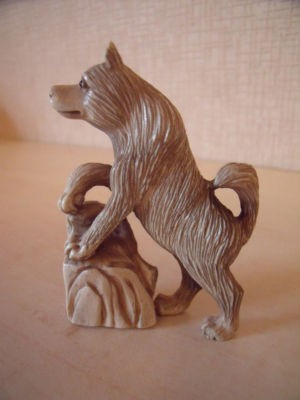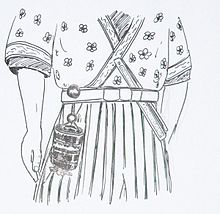
Back in the day, give or take three hundred years, the every-day kimonos that Japanese people wore didn’t have pockets. To hold their money, medicine, tobacco, or other small bits, they placed the items in containers (often baskets or pouches) called sagemono which hung by cords from a kimono’s obi, or belt. The fastener that secured the cord at the top of the sash was a carved, button-like toggle called a netsuke (pronounced “nets-keh”), and the netsuke was attached to the other end of the cord preventing the cord from slipping through the obi. A sliding bead, or ojime, was strung on the cord between the netsuke and the sagemono to allow the opening and closing of the sagemono. The whole ensemble was then worn, at the waist, and functioned as a sort of removable external pocket.
There is going to be a test at the end.
Over time, netsukes evolved from being strictly utilitarian items into beautiful works of art that are reminiscent of scrimshaw.

Drawing of a man wearing an inrō supported by a netsuke passed through the ties of his hakama. From Wikipedia
The most common material for a netsuke was marine ivory, but hardwoods, boar tusks, porcelain, lacquer or metal were also popular materials. The designs reflected important aspects of Japanese folklore and life, and included legendary heroes, mystical beasts, religious symbols, daily activities, and an assortment of animals that included dogs.
Most netsuke production was during the Edo period, around 1615–1868, and the art lives on today, eminently collectable items with some modern pieces commanding high prices. There are, of course, inexpensive reproductions to be found in souvenir shops, but even they hint at the craftsmanship involved.
There is an International Netsuke Society where you can read up on the history of the art, as well as find contemporary artists.
And we lied about the test.
Image of an Akita Netsuke
